Hunters is a weird episode of Star Trek:Voyager, perhaps most notable for the manner in which it flirts with serialisation.
More than any other episode of the fourth season, with the possible exception of The Gift, this mid-season episode seems to exist primarily in relation to the episodes around it. The script is very consciously a sequel to Message in a Bottle, with the crew discovering the ancient network of space stations is a two-way radio back to the Alpha Quadrant. It also introduces the Hirogen, an alien species that will recur in Prey, The Killing Game, Part I and The Killing Game, Part II. The story also sets up a narrative thread that will pay off in Hope and Fear, the season finale.

“Prey, tell.”
More than that, Hunters is an episode that is very consciously engaged with dangling threads of continuity. It resolves the relationship between Janeway and Mark that has haunted the lead character since Caretaker, offers Tom Paris some hint of reconciliation with the father who seemed so disappointed in Persistence of Vision, and even resolves the Maquis plot thread by tying back to Blaze of Glory. This is an episode that exists as something of a storytelling nexus point, a variety of intersecting threads all tied together as part of a single narrative.
Voyager had largely eschewed any attempt at long-form storytelling, perhaps in response to the trauma of the troublesome Kazon arc in the second season that led to ill-judged misfires like Alliances and Investigations. However, those early attempts at serialisation were heavily plot-driven, a series of stories building towards a number predetermined plot points. In contrast, the serialisation suggested by Hunters is looser; a collection of character beats, some earlier details that had largely been forgotten, some elements that might be useful in the future.

The farthest woman from home.
That said, Hunters seems just as cautious about long-form storytelling as The Gift was. As much as Hunters revives old story lines and character beats, it also makes a conscious effort to close many of them. Hunters makes it very clear that this level of serialisation will not be the default for the series going forward. The episode tidies away more loose threads than it unravels. The relationship between Kathryn Janeway and Mark Johnson is brought back purely so it can be ended. The Maquis are mentioned only to confirm they have been destroyed.
Still, there is something oddly intriguing about Hunters, a mostly quiet episode that exists primarily as both prelude and coda rather than a narrative in its own right. It is a quieter, stranger Voyager episode, even while introducing a race of giant space!hunters.
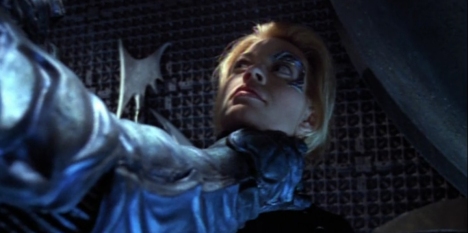
Gripping stuff.
Hunters is not Jeri Taylor’s last episode. Taylor would write One later in the season, a quieter character study focusing on Seven of Nine that worked so effectively as a bottle show that Star Trek: Enterprise would adapt it as Doctor’s Orders. Even after Taylor stepped away from role as executive producer at the end of the season, she would provide the script for Nothing Human early in the fifth season. So it is not entirely accurate to describe Hunters as Jeri Taylor’s farewell to the Star Trek franchise.
At the same time, the episode certainly provides a sense of closure to Jeri Taylor’s tenure as executive producer on Voyager. More than either of her later credits, Hunters speaks to a lot of what Jeri Taylor brought to the show as a producer and serves to wrap it all up in a neat bow so that Brannon Braga can have a (relatively) clean slate when he takes over the day-to-day running of the series starting with Night. This sense of resolution is reinforced in a number of ways, from the way that Taylor uses the letters from Earth through to the final scene with Janeway and Chakotay.

“I’m not sure he’s a good meal. His character arc seems somewhat undercooked.”
Hunters approaches the prospect of serialisation with some trepidation, which is understandable given the scars left by Voyager‘s last serious experiment with long-form storytelling. When Michael Piller returned to the series after a brief hiatus in the second season, he immediately set in motion a season-long arc involving the Kazon. The arc fell apart, for any number of reasons from resistance among a frustrated writing staff to the fact that the Kazon were terrible villains to the simple fact that the arc was rooted in a collection of plot points rather than characters.
That catastrophic misfire had lasting repercussions. The Kazon were awkwardly filed away in Basics, Part II, the last episode of the franchise to be written by co-creator and executive producer Michael Piller. Piller had been a fixture of the franchise for seven years, and was largely responsible for the revitalisation of Star Trek: The Next Generation during its third year. This ill-advised attempt at long-form storytelling involving aliens who wore rocks in their hair had humbled one of the most influential (and respected) producers ever to work on the franchise.

A touching interaction.
So it makes sense that Hunters should approach the subject of serialisation cautiously, dipping its toe gently (and almost apologetically) into the waters. Hunters does not seek out serialisation, but instead has serialisation thrust upon it. The episode opens in such a way as to make it very clear that the characters were not expecting Hunters to pick up directly from the end of Message in a Bottle, the signal from Starfleet coming as a surprise to the crew rather than as the result of some concentrated effort or trial and error.
To be fair, the closing scene of Message in a Bottle was constructed ambiguously enough that Voyager could easily avoid dealing with the fallout directly. The EMH promised, “They said they would contact your families to tell them the news and promised that they won’t stop until they’ve found a way to get Voyager back home. And they asked me to relay a message. They wanted you to know you’re no longer alone.” While the game had clearly changed, there was no explicit promise of on-going two-way communication, no matter how logical that might seem.

J and C, forever.
Indeed, in the teaser to Hunters, the crew seem almost alarmed that the network of relay stations from Message in a Bottle are still somehow relevant to the story being told in the very next episode. After all, Voyager has always had a short memory. The crew gave up on using the warp ten barrier after Threshold, even though the EMH cured the effects of transwarp travel. Following one failed attempt at opening a Borg transwarp conduit in Day of Honour, the crew gave up immediately and moved along. Even the Nekrit Expanse never seemed like a big deal.
With that in mind, it is understandable that the crew might have considered the connection with the Alpha Quadrant in Message in a Bottle to be a done-in-one deal, a nice excuse for a comedy episode in time for Sweeps. Harry reports with alarm, “Captain, the transmission was sent along the same network of alien relay stations we used to send the Doctor to the Alpha Quadrant.” Chakotay speculates, “Starfleet Command must be using them just like we did.” It is a very odd piece of exposition, one that makes a point to explain some self-evident internal logic.
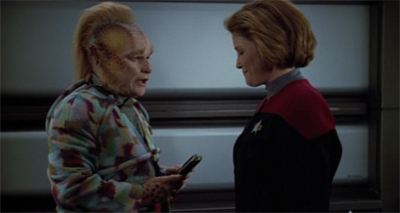
“That’s strange, we’re normally not allowed to carry plot points over from earlier episodes. Are you still mad at me for that time I became a drug dealer, or am I still an atheist from that time Seven cured death?”
If this technology existed in the world of the show, Starfleet would be crazy not to use it to remain in semi-regular contact with their long-lost ship. This is the kind of assumption that Star Trek: Deep Space Nine was carrying across episodes as early as the third or fourth seasons, with the communications relay set up in Destiny taken for granted as a potential resource in episodes like Paradise Lost and In Purgatory’s Shadow. It says a lot about Voyager that something as straightforward as this needs to be reiterated and explained, instead of being accepted immediately.
Hunters bends over backwards to provide exposition to explain every detail of what has happened and why it is happening, most notably in an awkward scene between Seven of Nine and the EMH. “In fact, if it weren’t for me, this transmission wouldn’t have been possible in the first place,” the EMH states. “I was the one who risked my matrix in order to go to the Alpha Quadrant. If we ever get home, I expect I’ll become quite the hero. Emergency Medical Hologram instrumental in the return of Voyager crew. Has a nice ring to it, don’t you think?”

“Emh, I think it’s a great idea.”
All of this over-explaining makes a much bigger deal of the serialisation than is really necessary, making the classic mistake of assuming that everything needs to be explained in the greatest detail possible. It is an approach that arguably makes serialisation seem more daunting than it really is. The only information that the audience needs going into Hunters is that Voyager found a network of relay stations that connect to the Alpha Quadrant. Everything else is an over-elaboration.
Hunters also rushes to reassure the audience that this is not going to be a regular occurrence. The episode ends with the destruction of the relay station network, which effectively resets the series to the earlier status quo. In her closing scene with Chakotay, Janeway acknowledges that Hunters was a blip in the larger scheme of things. “I think they were hoping mail call would become a regular part of their day,” she confesses of the crew, making it clear that things will get back to “normal” and that a potential change has been thwarted.

The skin he lived in.
Interestingly, the temporary connection with the Alpha Quadrant is primarily focused on the past, on tidying away the clutter of continuity loose ends. Hunters makes a point to resolve certain plot strands that can be traced back to Caretaker. This feels appropriate, given that Taylor would step down by the end of the season and Voyager would find itself being run by a writer who was not titled as a series co-creator and who did not share a writing credit on Caretaker. There is a sense that Taylor is packing away the toys.
This is most obvious in the revelations concerning Mark Johnson, the character who was introduced as Janeway’s fiancé and has spent the last three-and-a-half seasons separated from his love by seventy thousand light years. Mark never really felt like a character. In fact, he seldom felt like more than a vaguely-formed ideal, a lost love whose primary plot function seemed to be to stop Janeway from getting embroiled in the sort of episodic love stories that tend to embroil commanding officers like Elaan of Troyius, Captain’s Holiday, Second Sight or Civilisation.

“Set course for Counterpoint, maximum warp!”
Hunters effectively exorcises Mark, revealing that he has since moved on and married another woman. Indeed, Janeway openly talks about the letter as if it is a eulogy for the life that she thought was waiting for her back home. “Well, I knew he’d eventually move on with his life,” she confesses to Chakotay. “But there was such a finality to that letter.” It is a farewell, which is an ironic note to strike with a letter that in theory restores contact with a long-lost relative. It feels like the audience is saying goodbye to the version of Janeway defined by Mark.
Indeed, the closing scene of Hunters almost admits as much. Janeway explains that Mark was always more of a plot function than a character. “It made me realise that I was using him as a safety net, you know, as a way to avoid becoming involved with someone else,” Janeway acknowledges, which seems to be a fair assessment of the role that Mark played in Voyager‘s mythology. (It is hard not read it as a double-standard for the franchise’s first female commanding officer, as if the team were worried about giving Janeway a romance-of-the-week.)
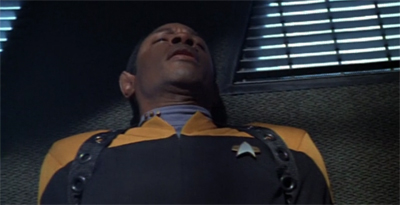
Harnessing his inner strength.
“You don’t have that safety net any more,” Chakotay reflects. It is a line that teases all manner of possibilities. It hints at a possible happy ending for Janeway and Chakotay, a chaste quasi-romantic relationship that Jeri Taylor had teased in scripts like Resolutions and Coda. Of course, Brannon Braga would opt not to explore that particular storytelling angle. If Hunters ties up the thread on Mark, it also seems to close the book on the relationship between Janeway and Chakotay. From here on out, Janeway and Seven is the character’s defining relationship.
In terms of saying goodbye to the version of Janeway written by Taylor, Hunters even pauses a moment to allow Janeway to indulge her inner scientist. “It’s amazing to me is that someone a hundred thousand years ago was harvesting microsingularities,” Chakotay remarks of the ancient relay stations. Janeway engages with the question. “If nobody shows up to protest, I’d like to stay here for a while. Try to find the answers to some of these questions. This is the kind of archaeological puzzle that’s always fascinated me.”

Not everybody’s cup of tea.
This was a characteristic of Janeway dating back to the first season, a nerdy enthusiasm for the weird and wonderful that reflected an officer who had risen through the science (rather than through the command) division. However, that version of the character was sidelined as the series came on, as episodes like Deadlock and Macrocosm allowed the production team to lay out a vision of a more badass Janeway written by Brannon Braga and very much in line with Kate Mulgrew’s conception of the character.
Indeed, confirming the sense that Hunters is an episode more concerned with tidying up continuity loose ends than in setting up new possibilities, that plot thread is very quickly dropped. Janeway’s curiosity about the relay station network is never mentioned again, and there is never any indication that the crew would ever attempt to get them working. Janeway’s interest in that “archaeological puzzle” is not setting anything in motion, it exists merely as an acknowledgement of Jeri Taylor’s approach to the character.

Homing in on the signal.
If Hunters is best read as Taylor’s fond farewell to these characters, it makes sense that the script should lean heavily on her previous work with them. Most interestingly, many of the character threads in Hunters were last really explored in Taylor’s early second season teleplay for Persistence of Vision, an episode written shortly before tensions with Michael Piller derailed the season. That episode marked the last appearances of Owen Paris and Mark Johnson, as hallucinations.
It also was the last episode to focus on the relationship between Chakotay and Torres, which seems like a strange detour in the larger context of the series. Torres and Chakotay both ended up involved in two very different ships; Torres would end up involved in a long-running relationship with Paris, while Chakotay was initially suggested to end up with Janeway before eventually pairing off with Seven of Nine as the show rushed to its end. Still, Hunters makes a point to give Chakotay and Torres a lovely and emotional scene together.
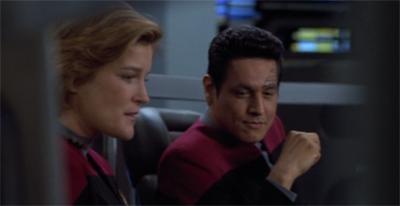
Chakotay and Janeway,
sitting in on the bridge…
However, Hunters does not just tie back into Taylor’s earlier work on the show, it also references her work on these characters outside the television series itself. Much like Coda alluded to details from Mosaic, Hunters nods towards some elements of Pathways. In Hunters, Chakotay alludes to “Sveta”, who is “the person who recruited [him] into the Maquis.” This is very obviously a nod to the character of Svetlana Korepanova from Pathways, Jeri Taylor’s semi-canon biography of the Voyager crew.
On that note, Hunters even makes a point to completely wrap up the dangling thread concerning the Maquis, the terrorists who joined the crew at the end of Caretaker. To be honest, Voyager had always seemed fairly ambivalent about the idea of populating the crew with former terrorists, outside of the occasional episode like Learning Curve or Meld. As such, it seemed inevitable that the production staff would take the opportunity to tidy away that distinction. “It’s over, B’Elanna,” Chakotay tells her. “There are no more Maquis.”
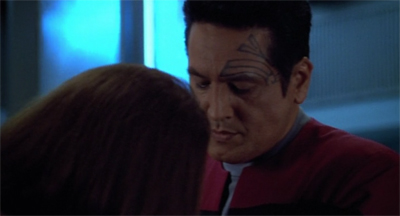
“B’Elanna, it’s time to give it a terrorest.”
This is a fascinating moment, on multiple levels. It is at once a clear example of Voyager trying to do away with a plot element for which it had little time, but it is also a great example of the strengths of continuity and long-form storytelling across multiple series in the larger franchise. Chakotay is not just referencing something that happened off-screen in the three-and-a-half year interim since the teaser to Caretaker. Chakotay is referencing something that was an explicit plot point on Deep Space Nine, in the episode Blaze of Glory.
In fact, this is the second time that Chakotay makes an reference to Deep Space Nine, the series that aired simultaneously with Voyager but also remained quite removed. When Janeway wonders what ace Starfleet might have up their sleeve to get the crew home, Chakotay speculates, “Starfleet found a stable wormhole to the Gamma Quadrant. Maybe they’ve discovered one that leads here.” It is a very small acknowledgement of Deep Space Nine, but is still a stronger connection than the shows had for the bulk of their runs.
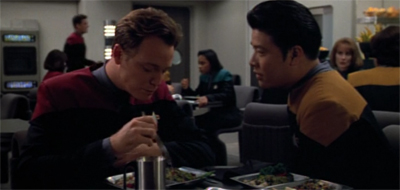
The Deep Space Nine between us.
Whereas Message in a Bottle was quite vague when it came to the Alpha Quadrant status quo that was being driven by the sixth season of Deep Space Nine, Chakotay offers a surprisingly in-depth account of what happened to the Maquis while Voyager was stranded in the Delta Quadrant. “It seems the Cardassians have an ally, a species from the Gamma Quadrant who supplied them with ships and weapons,” Chakotay explains. It is quick, but demonstrates much greater attention to detail than the handwave line about the war in in Message in a Bottle.
It is a great example of the way in which having these two narratives running in parallel can enrich and inform one another, where the very existence of Deep Space Nine affords Voyager storytelling opportunities that it might not otherwise have. If Deep Space Nine did not exist, writing out the Maquis in Hunters would feel like a lazy cop out; the sort of off-screen contrivance evoked by the end note that “Poochie died on the way back to his home planet.” Instead, it feels like a logical consequence flowing from a well-told story.

Taking a moment to drink it all in.
Perhaps more than anything else in this episode, the destruction of the Maquis demonstrates the potential of a reactive approach to continuity. It treats a long-form mythology as a series of rippling consequences rather than a single pre-determined narrative arc. This is largely how the story arc on Deep Space Nine developed, through improvisation and response, through taking stories in interesting directions and building off that. Doctor Bashir, I Presume was famously inspired by one of Alexander Siddig’s line readings in Homefront.
It is a much more organic approach to storytelling than that employed during the second season, where everything that happened on the series was dictated by a season-long build to a story like Basics, Part I rather than the interests of the production team or the strengths of the actors. The destruction of the Maquis was a story that Voyager could never have told by virtue of its Delta Quadrant setting, but which affords an array of interesting narrative possibilities upon which the writers and performers might capitalise.
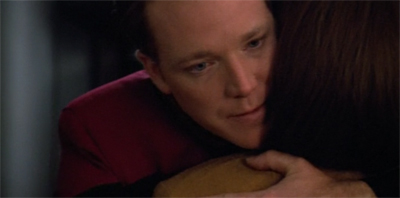
Hugging it out.
Tellingly, the destruction of the Maquis really energised the cast, who seemed to recognise the potential for interesting stories building out of that thread. As Roxann Dawson explained to Cinefantastique, there were any number of directions in which the story might go:
Noted Dawson, “There was a really interesting scene with Robert Beltran when he reveals information to me about the Maquis. I have to spend the rest of the show trying to deal with this information. I love that they’re bringing that up again. It’s one of the things that I feel was dropped too early. I would love them to deal with it some more. There is some encrypted Starfleet message that still hasn’t been decoded by the end of the episode. I would love it if they made a choice that Starfleet comes down hard in saying that, ‘Maybe all the Maquis should be thrown in the brig until we can get you home.’ I think it would be interesting to see how Janeway deals with that, and what kind of upset it might cause.”
Indeed, while Hunters works very hard to close off various character beats and choices from the Jeri Taylor era so as to afford Brannon Braga a clean slate, the episode also makes a point to offer some very open-ended storytelling hooks for any future writers to handle.
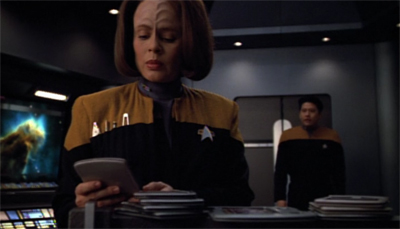
PADD-ing it out.
This is most obvious with the secret information encoded in the signal from Starfleet Command. The episode makes repeated reference to “encrypted Starfleet text” in the “latent datastream buried under the message.” The contents of this message are not revealed in Hunters. In fact, the script refuses to even hint at what the message might contain. As such, Hunters puts a wrapped present under the tree that can be unpacked at any time and which can be whatever those writers want it to be.
As with the question of what happens to the Maquis, it affords the new production team a wide latitude to tell a story that feels like an organic extension of Hunters without hemming it in too specifically. Unlike the serialisation of the second season, this form of long-form storytelling does not hem the creative team in to a predefined resolution. It instead lays a foundation upon which future writers can build pretty much anything they want. Appropriately enough, it would be Brannon Braga who would be the driving creative force on the follow-up episode, Hope and Fear.
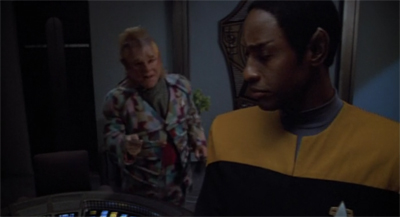
Taking his (Nee)lix…
That said, it is debatable whether Voyager manages to successfully build off the story threads set up in Hunters. The series does not address the emotional consequences of the destruction of the Maquis until Extreme Risk, the third episode of the fifth season. More than that, the point seems to be fairly quickly dropped. In Hope and Fear, it is revealed that the encoded data stream effectively amounts to little more than “we hope to see you soon.” Which seems like a very strange message to encrypt so heavily, in hindsight.
It would be churlish to blame Hunters for the botched follow-up to these plot threads. The point is that Hunters lays out what appears to be a relatively solid model of long-form storytelling going forward, stories that build on prior stories in interesting ways and which sets up a number of interesting angles that the series could choose to explore going forward. While obviously nowhere near as adventurous and committed as the sixth season, Hunters feels like the kind of gentle experimentation that marked the early seasons of Deep Space Nine.

Of Borg bondage.
More than that, there is something quite endearing in the space that Hunters affords its characters. It allows the cast room to breath, making a point to serve up dramatic beats and small character moments for every member of the primary staff. Indeed, even Neelix gets a very insightful role in the episode, assigned the duty of mailman for the messages and using that position to indulge his sense of self-importance. “Don’t pay any attention to rumours,” Neelix sternly advises the crew, enjoying the power a little too much. He even reads the letters en route.
Paris makes peace with his father. Tuvok discovers that he is a grandfather. Chakotay and Torres discover that the war they left behind has been resolved in their absence. Seven of Nine copes with the question of what might be awaiting her at home. Janeway witnesses the dissolution of a long-term relationship. Kim feels abandoned. Hunters is a more low-key an example ensemble-driven storytelling that made Year of Hell, Part I and Year of Hell, Part II so very effective.

Following orders, to the letters.
Indeed, Taylor is a writer who has tended to pay more attention to this aspect of Voyager, this sense of the crew as a community or family rather than a collection of professionals on a mission. Coda opened with similar character beats, discussing the crew’s “talent night” in a way that hinted at a more vibrant life for the cast and crew than that usually depicted. Taylor pays some measure of attention to who these characters are, which makes a great deal of sense given her working writing Mosaic and Pathways.
This attention to detail is reflected even in small unrelated conversations. On a shuttle trip, Seven of Nine asks Tuvok, “You have never lied?” Most of the Voyager writing staff would gloss past the question to get to the meat of this particular conversation. Instead, Taylor anchors the question in Tuvok’s past. “Only under orders from a superior officer,” he concedes. Of course, this seems fair. Tuvok must have lied in order to infiltrated the Maquis before Caretaker, and he certainly lied to Chakotay about Paris in the lead-up to Investigations.

“Sure, we could just patch these through the internal communications system, but then I wouldn’t get to power-trip over them.”
That said, there is also an awkwardness and crudeness to some of the character beats in Hunters. Taylor is a television veteran with decades of experience in the medium, but she is also a writer approaching the end of her career. Taylor has a decidedly old-school approach to characterisation and dialogue, with television characters frequently bluntly stating what they feel so that the audience does not have to concern itself with subtext or nuance. Given the emotionally-charged nature of the correspondence, that can be quite heavy-handed.
Character bluntly repeat their characteristics and emotions to one another, as if they are still strangers instead of people who have lived together for almost four years. “You shouldn’t get your hopes up, Harry,” Paris states. “No hopes, no disappointments.” Kim bitterly snipes, “I’m not you.” When Chakotay tries to sooth Torres, she bluntly responds, “Don’t! Don’t try to console me. I don’t want to be comforted.” Similarly, Torres’ needling of Kim about his attraction to Seven from Revulsion feels very stilted.

Tuvok had always been a scintillating conversationalist.
When Torres presses Paris on his affected disinterest, he lets his guard down almost instantly and recites a very crude explanation of his character motivation in the scene. “I don’t know exactly why, but the more everybody gets excited about these letters from home, the more I don’t want any part of it,” he states. “Maybe because what I have on Voyager is so much better than anything I ever had back there. I just don’t want the reminder.” It’s a nice character beat for Paris, given what he has been through and how he has grown. However, it is stated very bluntly.
This is how characters tend to relate to one another during the first season of a given television series, when the writers are largely fumbling to figure out an ensemble fits together and building a foundation for later storytelling. When the audience has no preexisting basis for judging a character and has yet to get comfortable with an actor, it makes sense to have them deliver blunt exposition about their emotional state. However, this is three-and-a-half years into the run. Voyager is half over. There is no excuse for drawing these character beats in crayon.

“You cannot just have characters state how they feel. That makes me angry.”
There is also an awkward sense that Hunters is not entirely comfortable with building an entire episode around the emotional journey of the characters. This is a long-standing issue with Voyager, a show that has long foregrounded plot at the expense of character. Voyager seems deeply uncomfortable with the idea of an episode based entirely around these character dynamics, and instead feels obliged to punctuate the story with a more conventional “the crew encounters a potentially hostile alien/phenomenon” subplot.
This is something that has happened repeatedly over the course of Voyager, most notably in episodes like The Swarm or Real Life. Indeed, even Taylor’s relatively character-driven teleplay for Resolutions made a point to feature a high-stakes battle with the Vidiians. In some ways, this anxiety about telling character-driven stories without interspacing them with a more conventional “sci-fi action” element is what holds Voyager back from a true masterpiece like The Visitor or The Inner Light.
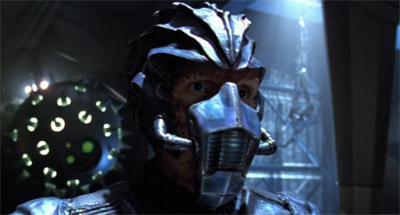
Next (Hiro)gen villains.
The “action sci-fi” beat in Hunters is the proper introduction of the Hirogen, following the tease in Message in a Bottle. In fact, it could be argued that Hunters commits too eagerly and too readily to showcasing the Hirogen, leading to a climax where Janeway faces down a fleet of Hirogen vessels and emerges relatively unscathed. In purely practical terms, it does little to establish the Hirogen as a credible long-term threat. This is not like the gradual development and reveal of the Dominion across the second season of Deep Space Nine.
Nevertheless, the Hirogen are a fascinating creation. They are in many ways one of the more memorable and iconic aliens from the seven-season run of Voyager. Although the bulk of their appearances come in the second half of the fourth season, in a very tightly-connected series of episodes only interrupted by Retrospect, the Hirogen made such a significant impact on Voyager that they got to make a (somewhat hard to logistically rationalise) guest appearance in Flesh and Blood, Part I and Flesh and Blood, Part II during the final season.

The hunt is on.
The basic idea for the Hirogen came from writers Brannon Braga and Bryan Fuller. As Joe Menosky relates to Cinefantastique, the pair were inspired by their television viewing habits:
“Brannon and Bryan Fuller were watching NFL one night, and Brannon came into the office the next day and said, ‘I think we should have some big, scary aliens.’ He just went on and on about how these football players are humongous. Why is it that everybody we ever see on our show in this big, wide, crazy galaxy is basically the same size as us? We got the idea of hunters, aliens who go around in pairs and hunt.”
This is not the first time that Braga has been inspired in his plotting by his television viewing habits. The character concept for Seven of Nine came to him when he caught a promo for Unity on UPN.
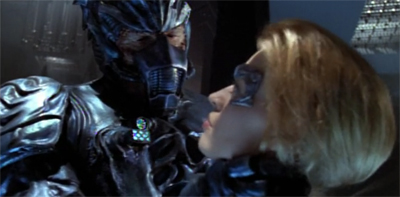
Creating new aliens every week? That’s a tall order…
This emphasis on the size of the Hirogen is an interesting choice, if only because it serves to make them feel more alien by pushing beyond the limits of the human form. Most Star Trek aliens are quite human-like in appearance, for obvious reasons. The make-up team are casting humans and working on tight budget and schedule, so inevitably there is a tendency towards cosmetic differences like pointed ears or nose ridges. However, the sheer size of the Hirogen makes them seem more strange and surreal. It recaptures that early mystery of the Delta Quadrant.
Reality inevitably set in. Voyager was a weekly television series, that found itself casting Hirogen actors for five episodes in quick succession. The production team could cast Tony Todd in Prey, and he could tower over the cast. However, by the time The Killing Game, Part I and The Killing Game, Part II rolled around, the Hirogen seemed rather more grounded and mundane. They no longer seemed larger than life. In fairness, like the ever-shrinking Great Hall on Qo’nos, this arguably fit within the context of their larger arc as they were demythologised.

Pressing concerns.
The Hirogen were the biggest challenge for me. They were originally seven foot men in these very big rubber suits. We had little time to do them. It became very apparent to me that there would be no movement, they couldn’t actually do anything once it was put together, we didn’t have the capability, time-wise, to articulate them. Quickly, we turned them into rubber suits rather than plastic suits. It was harrowing every inch of the way, I have to say, because the clock was ticking and there was no out, you had to do it.The first run of them, which was a seven show arc, and in that arc we changed the notion from seven foot actors, for a couple of reasons. We couldn’t find actors that were good enough, at seven foot, and, two, it became a shooting issue, how to get everybody in frame when you needed everybody in frame.
We backed down to six four actors, six two actors, six foot actors, and we then had to really find ways to adjust the garments, to shrink huge sizes down to small sizes and keep the integrity of the look. As we went into the next season, we were able to re-cast them in a lighter weight material, so that they were easier to move around in.
Once again, later episodes featuring the Hirogen like The Killing Game, Part I and The Killing Game, Part II or Flesh and Blood, Part I and Flesh and Blood, Part II would move away from those distinctive ridged costumes.

Old Man Vulcan.
Practical issues aside, the Hirogen make a very strong first impression in Hunters. They have a very strong central premise, one evoked by the title of the episode. With their fixation on the glory of the hunt and their gigantic stature, they obviously recall other iconic extraterrestrial hunters in popular culture. The Hirogen could arguably be seen as a loose adaptation of the aliens from the Predator films. On a purely aesthetic level, with their “trophies” and their harnesses, they fit within the b-movie aesthetic that defines the Alpha Quadrant and inspires Brannon Braga.
More than that, and perhaps fitting quite comfortably within the longer-form storytelling suggested by Hunters, the Hirogen could be seen as an attempt to rework and reinvent the Kazon. Both are primitive and tribal societies who exploit advanced technology developed by other cultures. Both chase Janeway and Voyager for its perceived exoticism. The defeat and capture of Voyager by the Hirogen in The Killing Game, Part I and The Killing Game, Part II could be seen as an excuse to revisit a plot employed by the Kazon in Basics, Part I and Basics, Part II.
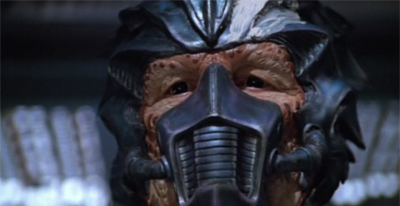
The Hirogen tower over the Kazon.
However, the Hirogen are not simply an excuse to repeat the Kazon. After all, the Kazon are among the most hated aliens in the Star Trek canon and writers like Jeri Taylor and Brannon Braga could not wait to be rid of them. The Hirogen could be seen as an attempt to revisit and explore many of the tropes that were botched with the handling of the Kazon in the first two seasons. The Hirogen could almost be seen as an attempt to “do right” by some of those basic ideas, right down to positioning them at the centre of a stronger multi-episode arc.
Of course, the Hirogen inherit some of the more uncomfortable racial politics associated with the Kazon. The Kazon were a collection of stereotypes about Los Angeles gang culture, rooted in a society of freed slaves. The subtext was very uncomfortable. The Hirogen have a few of those problematic aspects. They are presented as overly physical aliens who are savage and primitive, more overtly animalistic and beastly than most Star Trek aliens in that they refer to each other by designations used in packs of wild dogs. There is some potentially problematic subtext there.
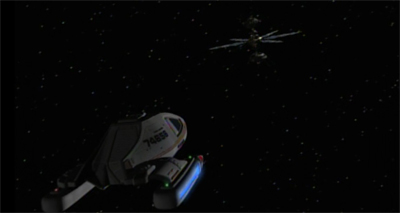
Relay station-keeping.
However, the Hirogen are constructed so as to avoid the more overtly racist aspects of the Kazon. Most obviously, there is the contextualising of the Hirogen within the larger framework of the Delta Quadrant. By and large, Voyager has conceptually imagined the Delta Quadrant as an interstellar third world, one populated by minor powers and scattered infrastructure in contrast to the more ordered major powers that occupy the Alpha, Beta and Gamma Quadrants. There are any number of episodes exploring this idea, from False Profits to Displaced to Day of Honour.
The Hirogen are defined as “big game hunters” who wander the Delta Quadrant in pursuit of prey, without any tie to the region. Interpreting Voyager through the lens of colonial and postcolonial theory, the Hirogen feel like a riff on the archetype of the “great white hunter”, the predatory outsider. They are not like the Akritirians from The Chute or the Drayans from Innocence, they are not a minor power preserving a tiny sphere of influence. They are more like other recurring threats in later seasons, like the Borg or the Malon, predators picking through the wasteland.
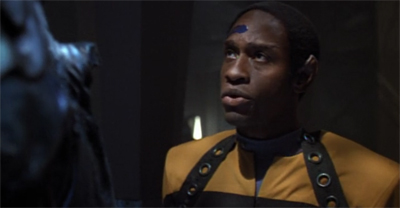
Mark his words.
Much like the environment destruction conducted by the Malon, the Hirogen hunt recalls the exploitation of third world countries by more powerful nations and interests. As Michelè Pickover outlines in Animal Rights in South Africa, the idea of hunting for sport and trophies was one of the key features of European colonialism in Africa:
Trophy hunting not only helped to finance colonialism; with imperialism, wild animals in Africa came to be seen as the personal property of the hunting elite. The British big-game hunting tradition was in many was linked to issues of class, elitism and the military, and perpetuated cultural notions of masculinity. In the colonial era, European hunters believed that their monopoly of the right to hunt made them superior to other races and that their civilisation increased ‘the beauty, courage and physical power of the race.’ Subsistence hunting was regarded as uncivilised and bad, while sport hunting was civilised and good. The same stereotypes – poaching versus trophy hunting – persist today.
Pointedly, the Hirogen do not hunt for food or supplies. They hunt solely for prestige. When Seven wonders what the Alpha Hirogen has planned for her intestine, the Alpha explains, “Unusual relics are prized. Yours will make me envied by men and pursued by women.” He panics when it looks like his trophies might not be exclusive.

Charting their larger arc.
While the Hirogen can trace their roots back to the iconic aliens from Predator, they are part of a much richer cultural tradition. The “big game hunter” or the “great white hunter” is a stock archetype that is instantly recognisable to anybody with any experience of popular culture. There are any number of examples from real life, such as Frederick Selous. Selous famously took Theodore Roosevelt on safari in East Africa in 1909, and was the primary inspiration for the pulp character of Allan Quatermain.
These issues are not merely historical. Poaching remains concern in third world countries, where wealthy tourists can afford to pay for the privilege of hunting local wild life. (Indeed, the Hostel series even blends this trope with The Most Dangerous Game, providing a twenty-first century context for the archetype.) Hunting is big business. In 2013, it was estimated that trophy hunting generated $70m for South Africa’s economy. The black market can be quite lucrative, with many international hunters paying for the privilege of hunting endangered wildlife.
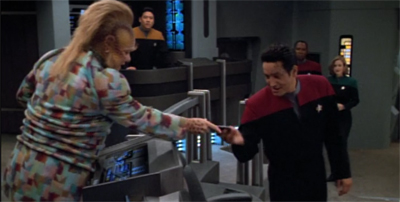
Bridging the divide between Alpha and Delta Quadrants.
“Trophy hunters are typically not going to be your average white-tailed deer hunter,” LaFontaine said. “Most of the folks who do this are men from a wealthier subset. These are people who, for vacation, go to an African country and pay up to tens of thousands of dollars for the opportunity to kill a lion, rhino or elephant that they can bring back home.”
LaFontaine added that trophy hunting is controversial for the way some believe it repeats systems of colonialism.
“When the government tells a local man in Chad that he can’t hunt but then allows a rich, white hunter from Texas to hunt, it’s a really terrible message to send,” he said. “It’s colonialistic and sends mixed signals to locals who see hunting is OK when a rich, white guy does it but not OK when a local does it.”
The Hirogen are contextualised within Voyager‘s awkward postcolonial framework. Like the Borg or the Malon, the Hirogen are treated as an opportunistic and exploitative power preying on a weak and divided quadrant.

Almost out of there…
It is a very clever way of avoiding the same problems that Voyager faced when it last tried to write about a tribalistic and nomadic Delta Quadrant species. The Hirogen are one of the most successful and memorable recurring antagonists from Voyager‘s entire run. It makes sense that these hunter aliens come to dominate this stretch of the fourth season, appearing in five of six consecutive episodes during the fourth season. They are a great design, built around a fascinating concept.
In fact, the Hirogen are so interesting as a potential antagonist that they can survive a somewhat botched introduction. For all that Message in a Bottle suggested an air of mystery about the Hirogen, and for all that Prey or The Killing Game, Part I and The Killing Game, Part II would work to establish the Hirogen as a credible threat, Hunters never manages to make the Hirogen seem especially imposing. They capture Tuvok and Seven because they have more advanced technology, but they are easily manipulated and goaded.
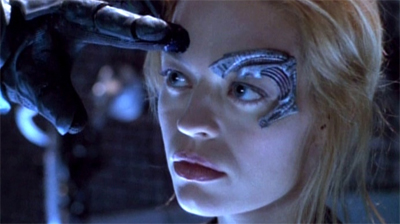
Painting a depressing picture.
“You are a crude species,” Seven of Nine states at one point in the episode, in response to the Alpha. “Only your size makes you formidable.” She certainly doesn’t seem wrong. Janeway manages to defeat four Hirogen vessels. The Alpha is presented as almost ridiculously insecure. There is an awkward sequence of the Alpha and Beta bickering among themselves as Janeway beams out Tuvok and Seven from directly behind them. Although he does not manage to incapacitate the Beta, Tuvok still manages to almost slit the throat of the Alpha.
This is not a convincing introduction for a recurring threat. Consider the way that the Borg were established in Q Who?, as an unstoppable force that would never hesitate and never relent. Contrast with the manipulations of the Dominion in The Jem’Hadar, brushing aside shields and force fields while blowing up Galaxy-Class starships. Going purely by this early encounter, the Hirogen in Hunters seem decidedly less credible antagonists than the pathetic Vidiians in Phage. However, later episodes do a much better job redeeming the alien threat.

Larger than life.
To be fair, this casual disregard for the Hirogen makes sense. These gigantic aliens might have inspired the title of the episode, but they are not the driving force. The Hirogen are a secondary concern in Hunters, a subplot that receives a reasonable amount of attention without ever seeming especially high stakes. Hunters is far more interested in the crew and their interactions with home, their brief connection back to Earth before it is snatched away. The Hirogen are almost a distraction from that.
Still, Hunters is an appealing little episode that builds well on what came before while still teasing the interesting stories that are to follow. Hunters is a rare episode of Voyager that has its eye on both the past and the future. It encapsulates a lot of the hope and potential of this fourth season, a lot of the understated efficiency of a series that feels like it is on the cusp of finding its groove.
You might be interested in our other reviews from the fourth season of Star Trek: Voyager:
- Scorpion, Part II
- The Gift
- Day of Honor
- Nemesis
- Revulsion
- The Raven
- Scientific Method
- Year of Hell, Part I
- Year of Hell, Part II
- Random Thoughts
- Concerning Flight
- Mortal Coil
- Waking Moments
- Message in a Bottle
- Hunters
- Prey
- Retrospect
- The Killing Game, Part I
- The Killing Game, Part II
- Vis à Vis
- The Omega Directive
- Unforgettable
- Living Witness
- Demon
- One
- Hope and Fear
Filed under: Voyager | Tagged: continuity, hirogen, Jeri Taylor, Maquis, mark johnson, serialisation, star trek, star trek: voyager, voyager |




















Ah, the Hirogen. It is impossible for me to give them a fair shake because they were built up for me by my dad. I remember he accidentally conflated them with species 8472, so after several years of build up I was expecting a truly memorable and terrifying species. What I got instead was yet another species that felt like Klingon light. Indeed, J.G. Hertzler and Tony Todd, two Klingon veterans, played some of the more memorable Hirogen characters. As a result, the species disappointed me greatly. In retrospect I suppose they work decently, but I feel as if they could have been stronger. I think they should have been a much darker and more threatening species. Maybe have them skin prisoners alive or something. As it is, their reputation as great hunters is never really delivered on, especially when they get defeated by their own holographic programs which is just ludicrous. Sadly, this is a trend in Voyager in that the species starts out with a somewhat intimidating introductory appearance and then by the end become a joke of what they once were.
I actually quite like the Hirogen, even if Hunters is not the best of introductions for them. I think they’re one of Voyager’s most interesting species, which isn’t the highest bar to pass. (They’re a little more interesting than Species 8472 for me, less interesting than the Vidians.)
At the risk of sounding like a nag, what’s your review schedule for the next month? More Voyager and DS9?
No worries about nagging! It’s good to talk.
I suspect it’ll be mostly DS9 and Voy, with films interspaced and the occasional opinion piece. Podcasts dropping every second Saturday, except in the case of a major release prompting a bonus episode.
However, I do plan to do Westworld and Legion at some point soonish. Maybe between S6/S7 of DS9. Maybe after DS9 entirely.
VGR’s fourth season recognises the need for something that was rather elusive during the show’s first three years – a need for change. When it came to jettisoning ideas that didn’t work (the Kazon as a recurring antagonist, Kes and Neelix’s toxic relationship), the writers and showrunners were such a slow study. It’s only now really the series is beginning to fulfil the potential of what VGR first held to audiences back in 1995.
S4 was the first to really introduce actual sweeping changes, like the inclusion of Seven of Nine, the departure of Jennifer Lien, leaving behind the regions of space Voyager wandered across from S1-3, and now with the flowing events of Message in a Bottle and Hunters, Starfleet becomes aware of Voyager’s predicament, and strives to do something about it.
Despite the exciting potential of that setup, it will be a while before VGR takes full advantage of it, but Hunters is a good start. Starfleet have ultimately made promises they can’t keep (as we’ll discover in Hope and Fear). Hunters teases the Voyager crew with a link to the Alpha Quadrant, only to take it away by the end, but not before the crew get letters from friends and family back home sent across the Hirogen relay network, and it changes each one of them in some way.
Hunters is quite high on character development, something often stunted by the show’s own premise. And one thing I particularly liked about Hunters is that despite the endless adventures of the Voyager crew, events on the other side of the galaxy continue to move on without them. This is the episode that drives that point home to them.
Janeway discovers her fiancée Mark has married someone else; Chakotay and Torres learn of the Maquis’ destruction by the Dominion; Tom’s father wants to reestablish relations with him (we surmise); Tuvok’s family haven’t given him up for dead after all, and now he’s a grandfather, and Harry, well, he just gets a letter from home (obviously, the writers are still disinterested in developing Harry’s character, and B’Elanna teasing Harry about his crush on Seven feels awkwardly shoehorned in from some other episode).
It’s nice to see the crew being forced to adjust to the news of these developments, even if they’re not telling us anything particularly noteworthy, but it shows that the writers are learning and picking up after the mistakes they’ve made over the past three years.
But having said that, Hunters is another disjointed S4 episode like The Gift or Revulsion. It has moments of interest and a dangerous new enemy – the Hirogen – but much like The Swarm, it tries to cram together two disparate plotlines when perhaps they should have been kept separate. But at least we see the Hirogen again so it doesn’t hurt the episode too much, unlike our fleeting glimpse of the Swarm in they’re one and only episode.
And what we see of the Hirogen opens up lots of possibilities for future storylines (much like the letters from home do). Seven and Tuvok are captured by them while retrieving more of Starfleet’s messages from an Hirogen module. The two hunters tower over Seven and Tuvok, planning to gut them and take they’re bones as a trophy, because they “took them in a fair hunt”.
Trek has an unfortunate tendency to humanise it’s foes too quickly (and the Hirogen are no exception), but at this stage the Hirogen are presented as a new, implacable and threatening enemy. They are the first proper recurring antagonist since the Kazon finally had the good sense to leave us after Basics, Pt II and although four of they’re ships are lost in a quantum singularity, the episode does enough of a good job of impressing upon us what a vicious enemy Voyager has made today.
Hunters is a worthwhile episode that continues the welcome changes this season has introduced, gives the cast plenty to sink they’re teeth into, and sets up an impressive new enemy that bodes well for the future of this season.
Was Voyager transported 70,000 light-years or 75,000 light-years? I thought the B’omar looked like football players too and Tuvok tries to slit the throat of the Hirogen Alpha.
Yep, the fourth season of Voyager marks a clear point of transition, to the point where you can almost neatly divide the show into “before/after.” The show itself invites this, in the way later episodes like Relativity, Fury and Shattered tend to blur all of pre-Seven-of-Nine Voyager together into one neat package.
What I found most annoying about throwing “we practice serialisation now” in the viewer’s face was Janeway explaining to Chakotay who Mark was. Would you not suspect that – given her’s and Chakotay’s rather close relationsip – he knows about this guy? Still, I rather liked Voyagers lose concept of serialisation, especially because it had a refreshing sense of surprise to it. Somehow they gave it up in or even before season 5 at some point, I cannot point down the exact moment. At least the Hirogen would return, which I found as interesting as you, Datten.
Rather distressing and disappointing at the same time is Harry’s alleged affection for Seven. Given the fact that still an considerable amount of her body is made up of technology it seems like Kim has somewhat a fetish for prosthetics or transhumanism of some kind and/or a rather devote attitude towards sexual partners. Seven might have an attractive look, but it is clearly hidden behind Borg-tech and her rude, uncompassionate behavior. I just think it is a strange subplot and it might be good that they treated it like a rumor/running gag after a while. In any case, it is sad to see that sexual clichés were so easily reproduced.
Now that you mention it, Kim is just coming off a crush on a holodeck character in Alter Ego… maybe you’re on to something.
Maybe a hot contender for a PhD-thesis in cultural studies? 😉
I wish they’d had the money/determination to keep the Hirogen huge, and I wish they’d doubled down and made their ships, weapons, and props bigger to match. I like the idea of various races having differing senses of scale – like how most Ferengi are shorter than humans.
This is something that could be done really well if Star Trek ever went the direction of a Clone Wars style of 3D animation drama.
John Scalzi’s book “Old Man’s War” has a scene of space marines destroying a city of aliens who are mere inches in height. It’s funny but also really dark.